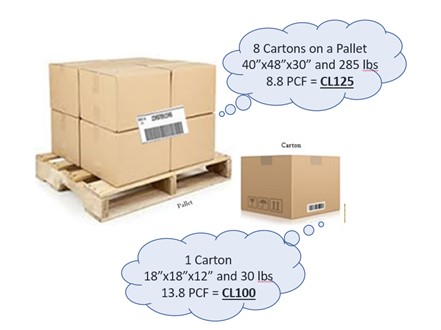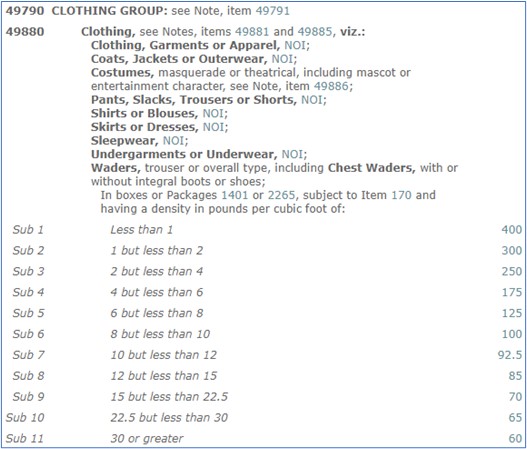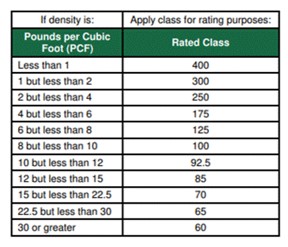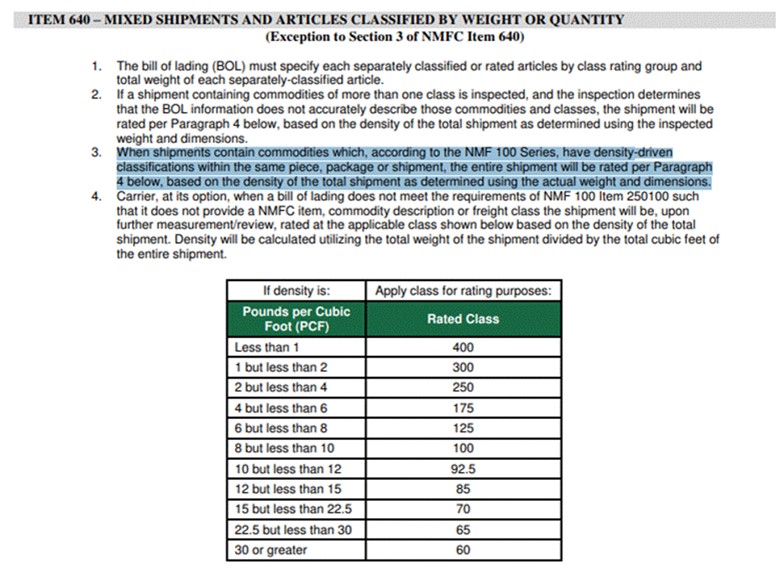-
03
Oct
Mixed Commodities Rule Item 640 – Roadmap to the Future?

The Mixed Commodity Rule Item 640 in the NMFC is a beast of an item. It is not only long and complicated, but it is also unfair to carriers in many cases and incredibly punitive to shippers in other situations. But this rule, particularly how carriers themselves have taken exception to this rule and published their own version, provides a possible roadmap to LTL pricing simplification. I’ve attached the item itself as a separate pdf attachment as it is too long to fit in this document.
The purpose behind Item 640 is to provide the rules of engagement for classifying shipments containing multiple commodities. It serves a secondary purpose of protecting carriers when shippers fail to describe the commodities properly. The problem with this item is two-fold: complexity, and lack of fairness.
Single Commodity Classification Examples
First, let’s look at how single-commodity shipments are classified. Today, the vast majority of commodities tendered as LTL are classified based upon density. Density is derived from weight and dimensions (cube), and the dimensions that matter are the dimensions of the handling unit, or pallet. The pallet itself is considered part of the shipment, both for weight and dimensional purposes. The challenge is that shippers tend to know the weight and dimensions of their individual cartons, but not the handling units as tendered to the carrier.
Let’s take an example shipment containing 8 cartons of clothing on a 40”x48” skid that is 6” tall and weighs 45 pounds. Each of the cartons is 18”x18”x12” and weighs 30 lbs. This equates to a density of 13.8 PCF and a classification of CL100 if the cartons are tendered loose. But once they are stacked on a skid, it is the total dimensions of the handling unit that matter. If we stack 8 of these cartons on a skid, we have 8 * 30 + 45 = 285 lbs, and the dimensions of the handling unit are 40”x48”x30”. That computes to a density of 8.8 PCF or CL125.

The shipper is apt to classify this shipment based upon the weight and dims of the individual cartons and describe this shipment as CL100. The carrier, on the other hand, will work from the dimensions of the handling unit and assign a CL125 rating. Here is how the freight charges might play out, based upon a neutral base rate and an 80% discount:
- Shipper says: 285 lbs at CL100 > charges = $223.54
- LTL Carrier says: 285 lbs at CL125 > charges = $274.88
The carrier will assess a $40 rebill, plus whatever they charge for a reclassification. This is a very common cause of invoice discrepancies.

Mixed Commodity Classification Examples
Now let’s assume that the 4 cartons on top contain a different type of clothing and their weight is only 20 lbs. Those cartons are CL125 based upon their 8.9 PCF density. Now we have a mixed commodity shipment per the NMFC’s rule in Item 640, as it contains articles subject to different classes. The Mixed Commodity rule allows shippers to itemize the classes on the BOL, with the skid weight being charged for at the lowest class applicable. Thus it is proper to describe this shipment as 120 lbs of CL100, 80 lbs of CL125, and a 45 lb pallet classed at CL100.
Not only is this a very complicated methodology for describing the BOL, but the carrier is actually short-changed relative to the original shipment. Note that the shipment size here has not changed, but the total weight has been reduced by 40 pounds. Now, rather than getting revenue based upon 285 lbs at CL125, they get compensated much less based upon 165 lbs of CL100 and only 80 lbs of CL125. Using the same neutral base rate and 80% discount, the charges are significantly reduced:
- Mixed Commodity: 165 lbs at CL100 and 80 lbs at CL125 > charges = $206.58
To review, here are the 3 shipments and their charges. Keep in mind the size of the handling unit is identical. The only thing that changes is the density and the weight. And because the density of each shipment is less than 10 PCF (pounds per cubic foot), the space occupied is far more important to the carrier than the weight.
- Shipper says: 285 lbs at CL100 > charges = $223.54
- LTL Carrier says: 285 lbs at CL125 > charges = $274.88
- Mixed Commodity: 165 lbs at CL100 and 80 lbs at CL125 > charges = $206.58
Mixed Commodity Components
Before we dive deeper into these 3 examples, let’s first identify some of the key clauses of the NMFC’s Item 640 rule. This will help you understand why the rule itself is so challenging and why the carriers themselves have chosen to deviate from this rule. Item 640 states that:
- If the multiple commodities are not itemized properly on the BOL by weight and class, charges are based upon the highest class in the handling unit.
- The shipper can itemize the multiple commodities at their respective classes so that they are NOT charged at the highest class, but they must attach a packing slip to the shipment.
- If the shipper itemizes the multiple commodities, but the carrier finds a weight discrepancy, the carrier can assess the weight difference to the highest classed article.
#1 is a doozy, and probably the biggest reason virtually every LTL carrier takes exception to (deviates from) the NMFC rule. If a carrier finds incorrect descriptions on the BOL of a multi-commodity shipment, they can rate the entire shipment at the highest class present! Here is an example. Say a shipper tenders a skid containing 1000 lbs of bricks CL55 and 100 lbs of hand tools CL125, and fails to describe the commodities correctly, the carrier can rate the entire 1,100 lbs at CL125!! I suppose the logic here was to make the rule so punitive to the shipper that it forces them to comply. This is an incredibly punitive way to address a shipper who fails to properly itemize commodities on the BOL.
#2 is not a big issue, as generally shippers should attach packing slips to shipments. This helps both the carrier and the consignee. But due to a strict interpretation of the rule, the shipper forgoes the benefits of itemizing commodities if they fail to attach a packing skip.
#3, similar to #1 above, tends to be punitive to the shipper. Most carriers deviate from this step and apply any weight discrepancy to the lowest-classed article in order to give the shipper the benefit of the doubt and not overly-penalize them. The reality is that the extra weight has to be applied somehow, and the structure of the Mixed Commodity rule provides for no truly fair method. More on that later.
LTL Carriers Take Exception To The NMFC’s Mixed Commodity Rule
Most LTL carriers take exception to the NMFC’s Item 640 for three reasons. First, properly applying this NMFC rule when a BOL error is found, requires the carrier to break down the pallet to verify each of the commodities tendered. This is a painstaking and impractical process that jeopardizes the integrity of the handling unit. It forces carriers to weigh and measure individual cartons. Second, application of this rule as noted is punitive to the shipper. It simply is not fair. Carriers use the reclassification fee as the punishment, or “stick”, to push the shipper to change behavior. No need to add salt to the wound with a super-high reclassification. That’s great for W&R revenue generation purposes but does little to foster a strong shipper-carrier relationship.
Third, when shippers do properly itemize the commodities on a multi-commodity shipment, the carrier tends to get short-changed. Why is that? Let’s go back to the classification rule that a single-commodity shipment is classed based upon the weight and dimensions of the entire handling unit. Consider the original example of 8 cartons measuring 18”x18”x12” sitting on a 40”x48” skid. Total cube here is 40” x 48” x 30” = 33.33 cubic feet. But you can see that the cartons are not covering up all of the skid’s surface. You have 4” of wasted space on the 40” plane, and 12” of wasted space on the 48” plane.
Based upon the 24” vertical height of the cartons, you have 8.66 cubic feet of empty (wasted) space. With a single-commodity shipment, the shipper generally pays for that wasted space. But with a multi-commodity shipment, based upon how the NMFC Item 640 rule works, the carrier generally gets left moving wasted space for nothing. And if the cartons are not stacked as a flat level surface on top, you can see how wasted space gets added to the top of the skid. That’s what the industry calls a “pyramid” pallet. Keep in mind that cones placed on top of a skid are considered part of the handling unit, and their height gets included. That’s a lot of wasted space to account for!

The path that most LTL carriers have taken is rather simple and elegant. It is to take the standard 11-sub density-by-class table that applies on Clothing, Plastic Articles, Sporting Goods, and so many other commodities, and use it as the basis for classifying the entire handling unit or shipment when a multi-commodity BOL discrepancy is found. This does two things. First, it makes application of the rule super-easy. The carrier simply needs to weigh and measure each handing unit, which they do a at a very high rate with their forklift scales and automated pallet dimensioners. No need to break down the pallet and inspect each commodity present. Heck, no inspection is needed at all! Second, this application is fair for both shipper and carrier as it allows for classification appropriately based upon handling unit density.

And taking it a step further, some LTL carriers have shifted towards a position whereby they apply a density-by-class table like this for all multi-commodity shipments containing at least one density-based commodity. Here is the full rule for one such carrier. Note the paragraph 3 highlighted which states that they will rate the entire such shipment based upon this table.

A Path Forward – Is There A Better Way?
So in the opening paragraph I stated that the Mixed Commodity rule provides a roadmap to LTL pricing simplification. What did I mean by that? Consider the following facts:
- The vast majority of commodities moving LTL today are classed based upon density
- Space matters; it is the largest driver of LTL carrier cost
- LTL carriers weigh around 90% of the handling units they transport using forklift scales
- LTL carriers dimension around 60% of the handling units they transport using automated pallet dimensioners
- Shippers can help carriers, and thereby curry favor, by providing accurate weights and dimensions on the BOL
- Shippers benefit in many ways from knowing the weights and dimensions of their handling units as tendered to the carrier
- LTL carrier costing models use profile variables like weight and dimensions to cost freight; these costing models DO NOT use class to cost freight
- Some LTL carriers already have or are rolling out pure profile-based pricing programs that use shipment weight and dimensions, and DO NOT use class.
- The classification section of the NMFC is 359 pages long and too complex
- LTL shippers no longer have traffic managers highly educated about the NMFC like they did 30 years ago
- Class-based rate tariffs can still serve a useful purpose in the LTL industry
How can shippers and carriers simplify LTL pricing? I see a two-step process:
- Ask shippers to provide accurate weights and dimensions by handling unit
- Use the 11-sub density-by-class table as the method for classifying freight.
Sure, this methodology cannot be used for all shippers. One of LTL’s greatest attributes is its flexibility relative to other modes. LTL can be utilized to move practically everything from barrels to telephone poles, not just palletized freight. And generally, when shipping LTL, you pay for the space you use. However, LTL is dominated by cardboard boxes moving on pallets. Any handling unit that is easily conveyed by a forklift and does not present any undue trailer-stowing or dock-handling considerations can be classified purely by density. And I am quite confident such handling units represent the vast majority of what is transported by LTL carriers today.
Heck, maybe the NMFTA can facilitate this methodology by developing an alternative classification guide that can be utilized by the entire industry. They could shrink this alternative from down from 359 pages to maybe just 2 pages.
If you are a shipper who tenders mostly palletized freight, talk to your LTL carrier partners about methods of simplifying your pricing structure. Have them shift you over to a profile-based or density-based program that works from the weights and dims of each handling unit. Rather than getting into arguments over whether you are shipping CL50 widgets or CL100 sprockets, or whether your widgets are made of plastic or rubber, or intended for commercial or household use, just weigh and measure each your handling units. Provide this information on the BOL, preferably on the Electronic BOL, so that the carrier has the data they need as they are picking up the freight.
This allows the carrier to cost your freight properly, ensuring they are receiving the right revenue on each shipment. They can begin optimizing their daily linehaul schedules using accurate data from your freight. They can reduce missed pickups as they now have a better handle on pickup trailer needs. Since carriers can only dimension about 60% of the freight in their network, they can focus less on measuring your freight and more on other shippers. And if you are indeed providing accurate data, both you and the carrier should be in agreement and invoice surprises should rarely if ever occur.
Shifting to a profile-based or density-based program is a win-win for LTL shippers and carriers, and helps eliminate many of the complicated and frustrating rules that we all have dealt with for far too long.
- (479) 461-1672
- Contact Us
